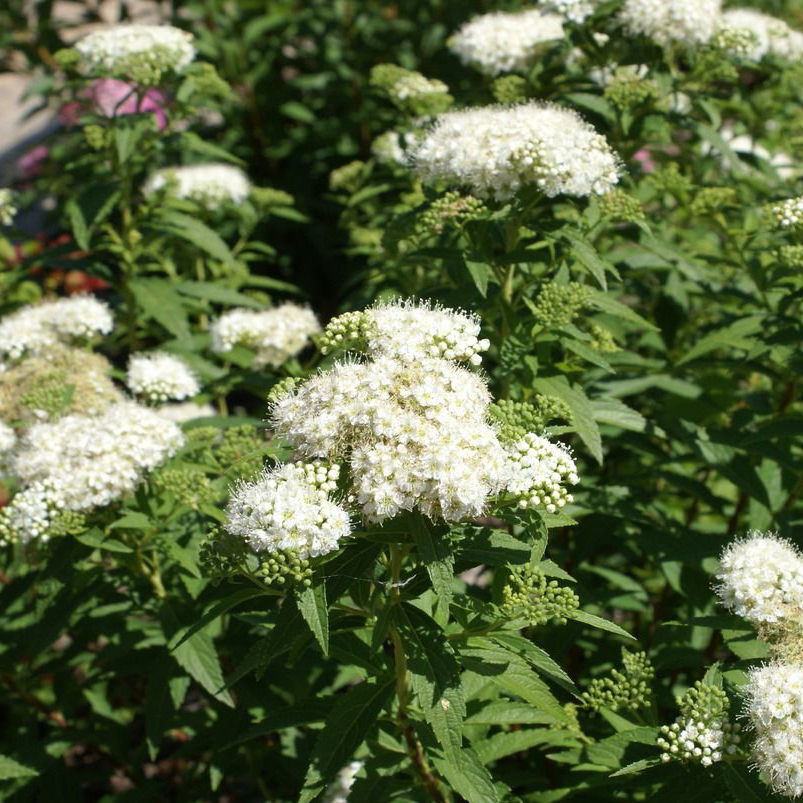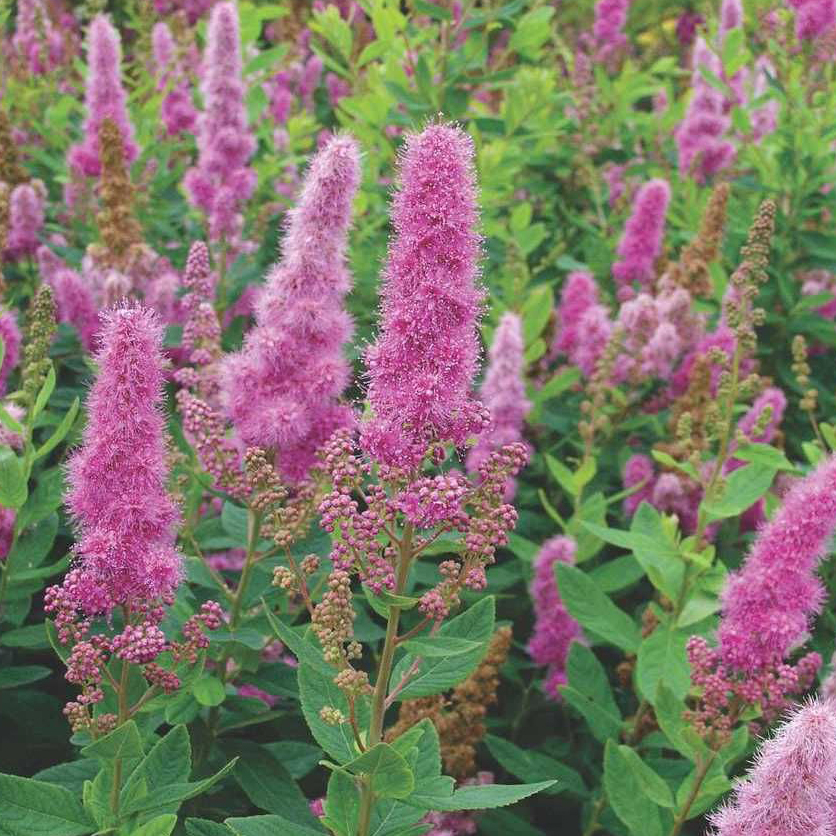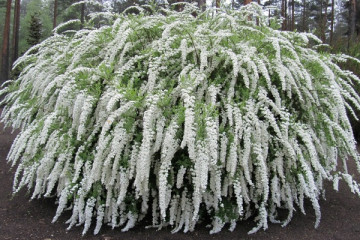Spirea (Spiraea) - species and varieties with white and pink flowers
Content:
Spirea is one of the few ornamental shrubs that can grow and bloom profusely, without requiring complex care. Not many indoor plants have this quality. It is very undemanding to the soil and, moreover, is frost-resistant. It is for these qualities that spirea fell in love with gardeners and landscape designers.
Popular species and varieties
An important quality of this shrub is the variety of species. They differ in height, appearance and color of inflorescences. There is also a difference in care between them. Sometimes it is not easy to make a choice in favor of a particular variety, but first of all, you should pay attention to the most popular varieties.
All types of spirea are divided into two groups according to flowering time:
- spring flowering;
- summer flowering.
The main distinguishing feature for these two groups is the color of the inflorescences. Shrubs from the first group, as a rule, have white or cream colored flowers. The second group, during the flowering period, is covered with inflorescences of pink and crimson shades.
Spring blooming
Among the group of spring flowering shrubs, there are leaders. There are several of them, here are the most popular:
- Spirea Wangutta;
- Spirea Dubravkolistnaya;
- Spirea of Nipponskaya;
- Spirea Thunberg;
- Spirea Average.
Summer blooming
The summer blooming group also has its own favorites. All of them have a pink color of inflorescences, but of a different shade. There are several types that gardeners are especially fond of:
- Spirea Ivolistnaya;
- Spirea White-flowered;
- Spirea Japanese;
- Spirea Douglas;
Among the common varieties, there are some that are controversial. For example, Kalinolistnaya spiraea (Kalinolistnaya meadowsweet) does not actually belong to this species. It is more correct to call such a shrub Bubble.
A similar situation applies to the name of the Rowan-leaved spirea. In fact, this is Ryabinnik. Both plants belong to the same family, but in different genera.
Crown shape
In the shape of the crown, this plant also amazes with its diversity, it can be:
- weeping;
- pyramidal;
- spherical;
- erect.
Almost all varieties lend themselves well to shaping, which allows the plant to be used as a hedge and in single plantings. To obtain a high green wall, the Slivolistny variety is suitable, it grows up to three meters in height.
Abundant flowering is also characteristic of all varieties. Differences are only in the color of the inflorescences, the period and duration of flowering.
Origin and diversity of species
Spirea belongs to the Rosaceae family. Its name comes from the Greek "speira" (spir), which means "bend". It is easy to guess that the shrub received such a name due to the properties of the branches to bend, especially under the weight of the inflorescences.
Under natural conditions, this shrub grows mainly on open elephants along the edges of forests. The area of its growth is wide. Spirea can be found in the European part of Russia, the Far East and Central Asia. Also in the halo of its growth includes Poland, Mongolia and the Balkans.
This shrub has been used in landscaping parks and gardens for a long time.Spirea Ivolistnaya became popular in the 16th century, and Berezolistnaya became popular in the 19th century.
The number of species of this ornamental plant is amazing - there are about 90 of them. Not all of them are widely known, but there are quite a lot of those that are actively used in landscape design.
How to choose a variety
It is very easy to get confused when choosing a variety of spirea, given the number of species of this plant. It is important to consider several factors here, which will be discussed below.
Features of cultivation in different regions
Some types of spirea are frost-resistant, and some varieties require shelter for the winter. The same is the case with watering, the need for moisture is different for each variety. Depending on the climate in the region and the owner's ability to take care of the shrub, you can give preference to one or another type of spirea.
In southern regions with milder climates, more thermophilic varieties of this shrub can be grown. But do not forget about timely watering: the drier the summer, the more moisture the plant will need.
In order to make the right choice, you need to pay attention to several more factors:
- Height. The size of the shrub in height, depending on the variety, can vary from 30 cm to 2.5 m.If there is enough free space on the site, you can choose tall varieties. In the event that the space is very limited, a stunted or even dwarf species is more suitable. You should also take into account the size of the plant in width.
- Coloring flowers. When choosing colors for composing a composition on a site, it is imperative to take into account the compatibility of colors. If some of the flowering plants have already been planted, then when choosing a variety of spirea, one should be guided by how the shade of its inflorescences will be in harmony with the rest of the flowers on the site. When drawing up a flower garden project from scratch, you can immediately determine the overall color scheme and focus on it.
- Flowering period. Typically, when choosing a plant for a flower arrangement, the goal is continuous flowering. Considering the flowering time of the rest of the plant, you should choose either an early or late type of shrub.
- Landing purpose. An ornamental shrub can be used as a single planting, as well as for a group planting, as well as for creating a hedge. Depending on the desired result, you must choose a variety.
Taking into account all these factors, it will be possible to make the most correct choice.
Where to plant spirea on the site
It is better to choose a place for planting spirea that is sunny and protected from the wind. It can also grow in partial shade and even in the shade, but this is often bad for its flowering.
This ornamental shrub is actively used in landscape design. It is used in flower beds, mixborders, and also as a separate composition from different species of this plant. Due to the fact that the flowering time of different species is different, you can create a composition of several species that will bloom continuously throughout the summer.
Spirea is also great for creating a hedge. You can choose the desired height for the future green wall. This shrub is easy to cut and grows fast. The creation of such a hedge does not require special physical costs and the acquisition of special knowledge. Even novice gardeners can do this.
Types of white spirea
Early spirea is also called White spirea because of the shade of the inflorescences.There are a lot of species of this shrub, but some deserve special attention.
Wangutta
Inflorescences are white. The height of the bush is from 1.5 to 2 meters. Easy to cut. Often used to create hedges. One of the popular varieties is the white bride spirea.
Nippon
Has a spherical crown shape. It reaches a height of 1 meter. Blooms early, in mid or late May. The flowers are white.
Dubravkolistnaya
It has a well-developed root system, which allows it to grow actively. The height of the bush is on average 1.5 meters. Inflorescences are white. It is actively used in urban landscaping.
Thunberg
A bush of medium height - 1-1.5 meters. The change in leaf color in autumn is a feature that this spirea possesses. Yellow foliage makes the bush even more spectacular during this period.
Gorodchaty
Flowers are collected in inflorescences and have a light cream color. Average height - up to 1 meter. The leaves have a ribbed (crenate) edge, which influenced the name of this species.
Gray
One of the tallest representatives of her species, it grows up to two meters in height. During the flowering period, it is covered with lush shield-like inflorescences of white color.
Arguta
The shape of the crown is spreading. The size of the shrub is quite large, reaching a height of 2 meters. Inflorescences are white and are located along the entire length of the shoots.
Average
One of the earliest flowering species - it blooms in May. Has a rounded bush shape. In spring it is covered with white corymbose inflorescences. During this period, it resembles a fountain of snow-white splashes.
Types of pink spirea
The shade of the inflorescences of this plant, which appear in summer, is usually pink, hence one of the names - pink spirea. Sometimes it can also be crimson, there are species with white inflorescences.
Willow
It got its name due to the similarity of the leaves with the tree of the same name. Their color changes to bright red in the fall. Reaches a height of 2.5 meters.
Japanese
The most popular variety. The height of the bush is small - only about 50 centimeters. The leaf is three-lobed. The flowering period is long, lasts 1.5 - 2 months.
Picture 11 Japanese
White
One of the few species that blooms in summer, which has white inflorescences. The height of the bush is about 1.5 meters. The flowering period begins in July and lasts until August.
Billard
Bred artificially by crossing the spirea Douglas and willow. The inflorescences are bright pink in color. The bush is quite high, about two meters.
Douglas
Inflorescences are pink panicles. The bush has an erect crown. Blooms from July to August.
Boomald
Spirea spire on the crown. The flower is paniculate, double, has a raspberry hue. Quite a popular look. The flowering period is almost two months.
Berezolistnaya
Low shrub (height about 60 centimeters) with a spherical crown. It got its name for the shape of the leaves resembling birch foliage. Inflorescences are white, sometimes with a pink tint. In autumn, the color of the foliage changes to golden.
Spirea - planting and care
Spirea, the care of which is minimal, is quite simple to grow. Care consists of several main points:
- Watering. Depending on the climate and the amount of precipitation in the spring and summer, the shrubs should be watered either once or 2-3 times a month. Most species are drought tolerant.
- Top dressing. In the spring it is necessary to apply the rate of mineral fertilizers, in the summer it is better to feed with organic ones. Ordinary compost can be used as organic matter.
- Pruning. Spirea needs a regular haircut. Formation is carried out in three stages - in spring, summer and autumn.
- Preventive treatment. Although this plant is very resistant to disease, it should still be regularly treated with preventive chemicals.
Getting a new copy is also not difficult. Reproduction is best done by cuttings. The stalk takes root over the summer and by the fall is ready for planting in the ground.
You can get a new plant by using a seed that ripens after flowering. But this process is much more painstaking and laborious.
Spirea, the types and varieties of which are striking in diversity, is very popular. You can use this plant both to decorate the site as a single planting, and to create a hedge. In any case, it will look impressive.
This is one of the few flowering shrubs that is quite easy to care for. It is enough to ensure timely watering, pruning and regular fertilization for full growth and flowering.
When choosing a variety, one should take into account the peculiarities of the climate of the region in which the site is located. Depending on this, you need to choose what the variety should be. First of all, you need to find its description and familiarize yourself with it.
Even a beginner can grow this unpretentious and very ornamental plant.





























